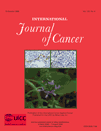Opposing associations of serum n-3 and n-6 polyunsaturated fatty acids with colorectal adenoma risk: An endoscopy-based case–control study
Abstract
Several human and animal studies have shown that n-3 polyunsaturated fatty acids (PUFA) might be associated with a decreased risk, whereas other studies showed that n-6 PUFA may be associated with an increased risk of colorectal cancer. However, results from these studies are not consistent. We evaluated the associations between serum n-3 and n-6 PUFA levels and colorectal adenoma risk in an endoscopy-based case–control study, conducted in The Netherlands between 1997 and 2002. We included 363 cases of colorectal adenomas and 498 adenoma-free controls. Serum fatty acids were measured in cholesteryl esters. Logistic regression models were used to calculate odds ratios (OR), which were adjusted for age, gender and alcohol intake. Total serum n-3 PUFA levels were inversely associated with colorectal adenoma risk, the OR comparing the third tertile with the first tertile was 0.67 [95% confidence interval (CI) 0.46–0.96, p for trend = 0.03]. Serum eicosapentaenoic acid (EPA; C20:5n-3) and docosahexaenoic acid (DHA; C22:6n-3) and the n-3/n-6 ratio were inversely associated with colorectal adenoma risk, but these were not statistically significant. In contrast, the risk of colorectal adenomas was increased by total n-6 PUFA with an OR of 1.68 (95% CI, 1.17–2.42, p for trend = 0.006) and by linoleic acid (LA; C18:2n-6) with an OR of 1.65 (95% CI, 1.15–2.38, p for trend = 0.007). This is the first observational study that simultaneously finds an inverse association of serum n-3 PUFA and a positive association of n-6 PUFA with colorectal adenoma risk. © 2008 Wiley-Liss, Inc.




